2023 ACURA Integra Seat Belts and Airbags User Guide
The 2023 Acura Integra is a great example of safety and sophistication in the world of car technology. This is especially clear in the way its seat belts and airbag systems were carefully made. As a sign of how much Acura cares about passenger safety, the Integra’s seat belts not only provide the important safety of restraint, but they can also be adjusted to fit passengers of different heights. The advanced airbags strategically put throughout the car’s interior are the final piece of this safety package. They are ready to go off with pinpoint accuracy in case of an accident. From the front to the back, the Acura Integra’s airbag network, which includes frontal, side, and possibly curtain airbags, is carefully made to protect the people inside. These thorough safety measures show how committed Acura is to making a driving experience where confidence and peace of mind go hand in hand. They also make sure that every trip comes with the peace of mind that comes from using the latest safety technologies.
For Safe Driving
The following pages explain your vehicle’s safety features and how to use them properly. The safety precautions below are ones that we consider to be among the most important.
Important Safety Precautions
- Always wear your seat belt
A seat belt is your best protection in all types of collisions. Airbags are designed to supplement seat belts, not replace them. So even though your vehicle is equipped with airbags, make sure you and your passengers always wear your seat belts, and wear them properly. - All children
Children ages 12 and under should ride properly restrained in a back seat, not the front seat. Infants and small children should be restrained in a child seat. Larger children should use a booster seat and a lap/shoulder seat belt until they can use the belt properly without a booster seat. - Be aware of airbag hazards
While airbags can save lives, they can cause serious or fatal injuries to occupants who sit too close to them, or are not properly restrained. Infants, young children, and short adults are at the greatest risk. Be sure to follow all instructions and warnings in this manual. - Don’t drink and drive
Alcohol and driving don’t mix. Even one drink can reduce your ability to respond to changing conditions, and your reaction time gets worse with every additional drink. So don’t drink and drive, and don’t let your friends drink and drive, either. - Some states, provinces and territories prohibit the use of cell phones other than hands-free devices by the driver while driving.
- Pay appropriate attention to the task of driving safely
Engaging in cell phone conversation or other activities that keep you from paying close attention to the road, other vehicles, and pedestrians could lead to a crash. Remember, situations can change quickly, and only you can decide when it is safe to divert some attention away from driving. - Control your speed
Excessive speed is a major factor in crash injuries and deaths. Generally, the higher the speed, the greater the risk, but serious injuries can also occur at lower speeds. Never drive faster than is safe for current conditions, regardless of the maximum speed posted. - Keep your vehicle in safe condition
Having a tire blowout or a mechanical failure can be extremely hazardous.
To reduce the possibility of such problems, check your tire pressures and condition frequently, and perform all regularly scheduled maintenance. - Do not leave children unattended in the vehicle
Children, pets, and people needing assistance left unattended in the vehicle may be injured if they activate one or more of the vehicle controls. They may also cause the vehicle to move, resulting in a crash in which they and/or another person(s) can be injured or killed. Also, depending on the ambient temperature, the temperature of the interior may reach extreme levels, which can result in harm or death. Even if the climate control system is on, never leave them in the vehicle unattended as the climate control system can shut off at any time.
Your Vehicle’s Safety Features
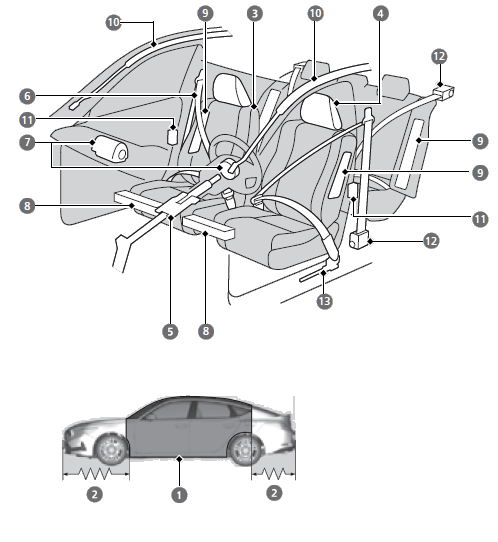
- Safety Cage
- Crush Zones
- Seats and Seat-Backs
- Head Restraints Collapsible Steering Column Seat Belts
- Front Airbags
- Knee Airbags
- Side Airbags
- Side Curtain Airbags
- Door Locks
- Seat Belt Tensioners
- Outer Lap Pretensioners
The following checklist will help you take an active role in protecting yourself and your passengers.
Your vehicle is equipped with many features that work together to help protect you and your passengers during a crash.
Some features do not require any action on your part. These include a strong steel framework that forms a safety cage around the passenger compartment, front and rear crush zones, a collapsible steering column, and tensioners that tighten the front and outer rear seat belts in a sufficient crash.
However, you and your passengers cannot take full advantage of these features unless you remain seated in the correct position and always wear your seat belts. In fact, some safety features can contribute to injuries if they are not used properly.
Safety Checklist
For the safety of you and your passengers, make a habit of checking these items each time before you drive.
- After everyone has entered the vehicle, be sure all doors and the hatch are closed and locked. Locking the doors and the hatch helps prevent an occupant from being ejected and an outsider from unexpectedly opening a door or the hatch.
Locking/Unlocking the Doors from the Inside P. 158 - Adjust your seat to a position suitable for driving. Be sure the front seats are adjusted as far to the rear as possible while allowing the driver to control the vehicle. Sitting too close to a front airbag can result in serious or fatal injury in a crash.
Seats P. 191 - Adjust head restraints to the proper position. Head restraints are most effective when the center of the head restraint aligns with the center of your head. Taller persons should adjust their head restraint to the highest position.
Adjusting the Front Head Restraint Positions P. 198 - Always wear your seat belt, and make sure you wear it properly. Confirm that any passengers are properly belted as well.
Fastening a Seat Belt P. 45 - Protect children by using seat belts or child seats according to a child’s age, height, and weight.
Child Safety P. 68
If the door and/or hatch open message appears on the driver information interface, a door and/or the hatch is not completely closed. Close all doors and the hatch tightly until the message disappears.
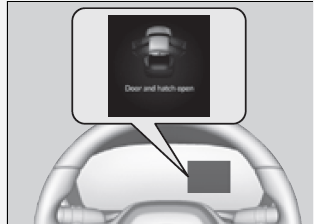
Seat Belts
About Your Seat Belts
Seat belts are the single most effective safety device because they keep you connected to the vehicle so that you can take advantage of many built-in safety features. They also help keep you from being thrown against the inside of the vehicle, against any passengers, or out of the vehicle. When worn properly, seat belts also keep your body properly positioned in a crash so that you can take full advantage of the additional protection provided by the airbags.
In addition, seat belts help protect you in almost every type of crash, including:
- Frontal impacts
Side impacts
Rear impacts
Rollovers
Lap/shoulder seat belts
All five seating positions are equipped with lap/shoulder seat belts with emergency locking retractors. In normal driving, the retractor lets you move freely while keeping some tension on the belt. During a collision or sudden stop, the retractor locks to restrain your body.
The front passenger’s and rear seat belts also have a lockable retractor for use with child seats.
Installing a Child Seat with a Lap/Shoulder Seat Belt P. 75
WARNING
Not wearing a seat belt properly increases the chance of serious injury or death in a crash, even though your vehicle has airbags.
Be sure you and your passengers always wear seat belts and wear them properly.
If you extend the seat belt too quickly, it will lock in place. If this happens, slightly retract the seat belt, then extend it slowly.
Seat belts cannot completely protect you in every crash. But in most cases, seat belts can reduce your risk of serious injury.
Most states and all Canadian provinces and territories require you to wear seat belts.
Proper use of seat belts
Follow these guidelines for proper use:
- All occupants should sit upright, well back in the seat, and remain in that position for the duration of the trip. Slouching and leaning reduce the effectiveness of the belt and can increase the chance of serious injury in a crash.
Never place the shoulder part of a lap/shoulder seat belt under your arm or behind your back. This could cause very serious injuries in a crash.
Two people should never use the same seat belt. If they do, they could be very seriously injured in a crash.
Do not put any accessories on the seat belts. Devices intended to improve comfort or reposition the shoulder part of a seat belt can reduce the protective capability and increase the chance of serious injury in a crash.
If a passenger moves around and extends the seat belt, the lockable retractor may activate. If this happens, release the retractor by unfastening the seat belt and allow the belt to retract completely. Then, refasten the belt.
Seat Belt Reminder
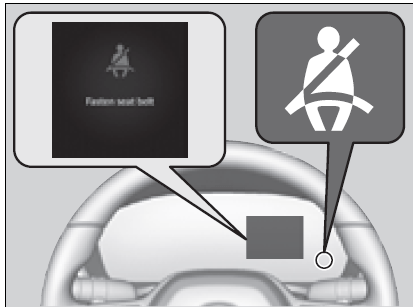
Front seats
The seat belt system includes an indicator on the instrument panel to remind the driver or a front passenger or both to fasten their seat belts.
If you set the power mode to ON and a seat belt is not fastened, a beeper will sound, and the indicator will blink. After a few seconds, the beeper will stop and the indicator will come on and remain illuminated until the seat belt is fastened.
The beeper will periodically sound and the indicator will blink while the vehicle is moving until the seat belt is fastened.
The indicator will also come on if a front passenger does not fasten their seat belt within six seconds after the power mode is set to ON.
When no one is sitting in the front passenger’s seat, the indicator will not come on and the beeper will not sound.
The indicator also may not come on and the beeper may not sound when the occupant is not heavy enough to trigger the weight sensor. Such occupants (e.g., infants and smaller children) should be moved to the rear seat as a deploying front airbag likely will injure or kill them.
Rear seats
Your vehicle monitors rear seat belt use. The driver information interface notifies you if any of the rear seat belts are unfastened after they were previously fastened.
In order to encourage the driver to evaluate rear seat belt usage, the display appears when:
- Any of the rear passenger seat belts are unfastened when the power mode is set to ON.
A rear door is opened and then closed.
Any of the rear passengers fasten or unfasten their seat belt.
The seat belt reminder indicator blinks and the beeper sounds if any rear passenger seat belts are unfastened while driving.
The system will not detect a passenger in the rear seats who has not fastened the seat belt.
The driver should check the status of the rear passengers’ seat belts at the start of each trip and each time a passenger is seated in the rear seats, using the driver information interface as an aid. An alert will sound if a passenger in the rear seats unfastens the seat belt while the vehicle is in motion or if motion resumes while the graphic is red.
The driver information interface uses colors to aid the driver in checking the status of the passengers.
For the rear seating positions:
- Green indicates the seat belt is fastened.
- An unfastened gray graphic indicates the seat belt has not been fastened recently.
An unfastened red graphic indicates the seat belt was unfastened recently.
The system does not monitor harnesses that are part of a child seat, nor the anchors of the LATCH system. While the system can inform you that a seat belt is fastened, it cannot determine whether a child seat is properly installed or used.

Automatic Seat Belt Tensioners
The front seats and the outer rear seats are equipped with automatic seat belt tensioners to enhance safety.
The tensioners automatically tighten the front seat belts and the outer rear seat belts during a moderate-to-severe frontal collision, sometimes even if the collision is not severe enough to inflate the front airbags or the knee airbags.

The seat belt tensioners can only operate once.
If a tensioner is activated, the SRS indicator will come on. Have a dealer replace the tensioner and thoroughly inspect the seat belt system as it may not offer protection in a subsequent crash.
During a moderate-to-severe side impact, the tensioner on both sides of the vehicle also activates.
Fastening a Seat Belt
After adjusting a front seat to the proper position, and while sitting upright and well back in the seat:
2 Seats P. 191
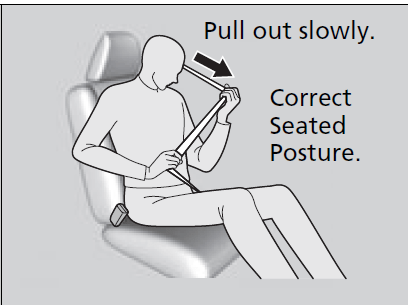
- Pull the seat belt out slowly.
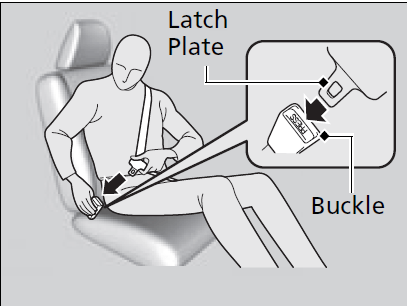
- Insert the latch plate into the buckle, then tug on the belt to make sure the buckle is secure.
- Make sure that the belt is not twisted or caught on anything.
No one should sit in a seat with an inoperative seat belt or one that does not appear to be working correctly. Using a seat belt that is not working properly may not protect the occupant in a crash. Have a dealer check the belt as soon as possible.
Never insert any foreign objects into the buckle or retractor mechanism.
If the seat belt appears to be locked in a fully retracted position, firmly pull out on the shoulder belt once, then push it back in.
Then, smoothly pull it out of the retractor and fasten. If you are unable to release the seat belt from a fully retracted position, do not allow anyone to sit in the seat, and take your vehicle to a dealer for repair.
- Make sure that the belt is not twisted or caught on anything.
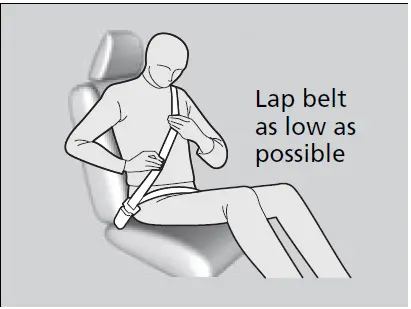 Position the lap part of the belt as low as possible across your hips, then pull up on the shoulder part of the belt so the lap part fits snugly. This lets your strong pelvic bones take the force of a crash and reduces the chance of internal injuries.
Position the lap part of the belt as low as possible across your hips, then pull up on the shoulder part of the belt so the lap part fits snugly. This lets your strong pelvic bones take the force of a crash and reduces the chance of internal injuries.- If necessary, pull up on the belt again to remove any slack, then check that the belt rests across the center of your chest and over your shoulder. This spreads the forces of a crash over the strongest bones in your upper body.
Adjusting the Shoulder Anchor
The front seats have adjustable shoulder anchors to accommodate taller and shorter occupants.
- Move the anchor up and down while holding the release button.
- Position the anchor so that the belt rests across the center of your chest and over your shoulder.
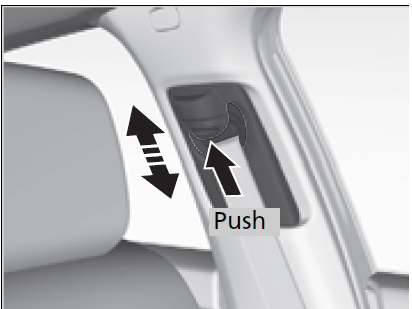
WARNING
Improperly positioning the seat belts can cause serious injury or death in a crash.
Make sure all seat belts are properly positioned before driving.
To release the belt, push the red PRESS button and then guide the belt by hand until it has retracted completely.
When exiting the vehicle, be sure the belt is properly stowed so that it will not get caught in the closing door.
The shoulder anchor height can be adjusted to four levels. If the belt contacts your neck, lower the height one level at a time.
After an adjustment, make sure that the shoulder anchor position is secure.
Advice for Pregnant Women
If you are pregnant, the best way to protect yourself and your unborn child when driving or riding in a vehicle is to always wear a seat belt and keep the lap part of the belt as low as possible across the hips.
Wear the shoulder belt across the chest avoiding the abdomen.
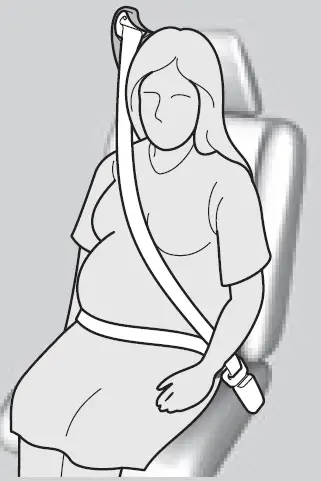
Wear the lap part of the belt as low as possible across the hips.
Each time you have a checkup, ask your doctor if it is okay for you to drive.
To reduce the risk of injuries to both you and your unborn child that can be caused by an inflating front airbag:
- When driving, sit upright and adjust the seat as far back as possible while allowing full control of the vehicle.
When sitting in the front passenger’s seat, adjust the seat as far back as possible.
Seat Belt Inspection
Regularly check the condition of your seat belts as follows:
- Pull each belt out fully, and look for frays, cuts, burns, and wear.
Check that the latch plates and buckles work smoothly, and the belts retract easily.- If a belt does not retract easily, cleaning the belt may correct the problem. Only use a mild soap and warm water. Do not use bleach or cleaning solvents. Make sure the belt is completely dry before allowing it to retract.
Any belt that is not in good condition or working properly will not provide proper protection and should be replaced as soon as possible.
A belt that has been worn during a crash may not provide the same level of protection in a subsequent crash. Have your seat belts inspected by a dealer after any collision.
WARNING
Not checking or maintaining seat belts can result in serious injury or death if the seat belts do not work properly when needed.
Check your seat belts regularly and have any problem corrected as soon as possible.
Airbags
Airbag System Components
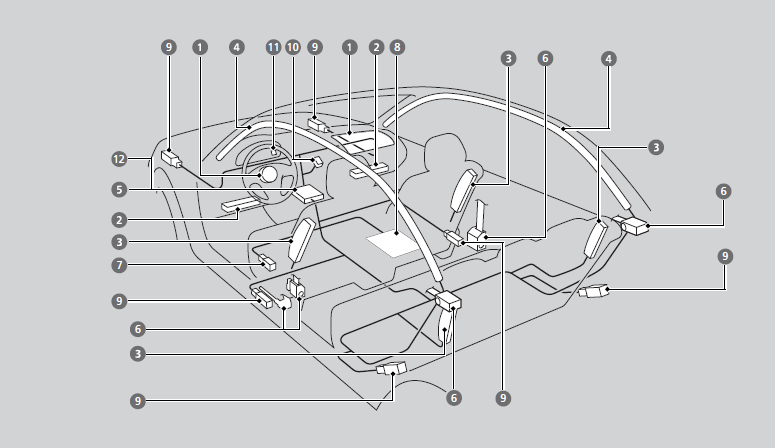
The front, driver’s knee, front passenger’s knee, side, and side curtain airbags are deployed according to the direction and severity of impact. Both side curtain airbags are deployed in a rollover. The airbag system includes:
- Two SRS (Supplemental Restraint System) front airbags. The driver’s airbag is stored in the center of the steering wheel; the front passenger’s airbag is stored in the dashboard. Both are marked SRS AIRBAG.
- Two knee airbags. The driver’s knee airbag is stored under the steering column; the front passenger’s knee airbag is stored under the glove box. Both are marked SRS AIRBAG.
- Four side airbags, one for the driver, one for the front passenger and two for the rear outboard seating positions. The front airbags are stored in the outer edges of the seat-backs and the rear airbags are stored next to the outer rear seating positions. All are marked SIDE AIRBAG.
- Two side curtain airbags, one for each side of the vehicle. The airbags are stored in the ceiling, above the side windows. The front and rear pillars are marked SIDE CURTAIN AIRBAG.
- An electronic control unit that, when the power mode is in ON, continually monitors information about the various impact sensors, seat and buckle sensors, rollover sensor, airbag activators, seat belt tensioners, and other vehicle information. During a crash event the unit can record such information.
- Seat belt tensioners for the front seats and outer rear seats. In addition, the driver’s and front passenger’s seat belt buckles incorporate sensors that detect whether or not the belts are fastened.
- Driver’s seat position sensor. This sensor detects the driver’s seat slide position to help determine the optimal deployment of the driver’s airbag.
- Weight sensors in the front passenger’s seat. The sensors are used for occupant classification to activate or deactivate the front passenger’s airbag.
- Impact sensors that can detect a moderate-to-severe front or side impact.
- An indicator on the center console that alerts you that the front passenger’s front airbag has been turned off.
- An indicator on the instrument panel that alerts you to a possible problem with your airbag system or seat belt tensioners.
- A rollover sensor that can detect if your vehicle is about to roll over and signal the control unit to deploy both side curtain airbags.
Important Facts About Your Airbags
Airbags can pose serious hazards. To do their job, airbags must inflate with tremendous force. So, while airbags help save lives, they can cause burns, bruises, and other minor injuries, sometimes even fatal ones if occupants are not wearing their seat belts properly and sitting correctly.
What you should do: Always wear your seat belt properly and sit upright and as far back from the steering wheel as possible while allowing full control of the vehicle. A front passenger should move their seat as far back from the dashboard as possible.
Remember, however, that no safety system can prevent all injuries or deaths that can occur in a severe crash, even when seat belts are properly worn and the airbags deploy.
Do not place hard or sharp objects between yourself and a front airbag. Carrying hard or sharp objects on your lap, or driving with a pipe or other sharp object in your mouth, can result in injuries if your front airbag inflates.
Do not attach or place objects on the front, driver’s knee and front passenger’s knee airbag covers. Objects on the covers marked SRS AIRBAG could interfere with the proper operation of the airbags or be propelled inside the vehicle and hurt someone if the airbags inflate.
Do not attempt to deactivate your airbags. Together, airbags and seat belts provide the best protection.
When driving, keep hands and arms out of the deployment path of the front airbag by holding each side of the steering wheel. Do not cross an arm over the airbag cover.
Types of Airbags
Your vehicle is equipped with four types of airbags:
- Front airbags: Airbags in front of the driver’s and front passenger’s seats.
Knee airbags: Airbags under the steering column and under the glove box.
Side airbags: Airbags in the driver’s and front passenger’s outer seat-backs and next to the outer rear seating positions.
Side curtain airbags: Airbags above the side windows.
Each is discussed in the following pages.
Front Airbags (SRS)
The front SRS airbags inflate in a moderate-to-severe frontal collision to help protect the head and chest of the driver and/or front passenger.
SRS (Supplemental Restraint System) indicates that the airbags are designed to supplement seat belts, not replace them. Seat belts are the occupant’s primary restraint system.
Housing Locations
The front airbags are housed in the center of the steering wheel for the driver, and in the dashboard for the front passenger. Both airbags are marked SRS AIRBAG.
The airbags can inflate whenever the power mode is in ON.
After an airbag inflates in a crash, you may see a small amount of smoke. This is from the combustion process of the inflator material and is not harmful. People with respiratory problems may experience some temporary discomfort. If this occurs, get out of the vehicle as soon as it is safe to do so.
During a frontal crash severe enough to cause one or both front airbags to deploy, the airbags can inflate at different rates, depending on the severity of the crash, whether or not the seat belts are latched, and/or other factors. Frontal airbags are designed to supplement the seat belts to help reduce the likelihood of head and chest injuries in frontal crashes.
Operation
Front airbags are designed to inflate during moderate-to-severe frontal collisions. When the vehicle decelerates suddenly, the sensors send information to the control unit which signals one or both front airbags to inflate.
A frontal collision can be either head-on or angled between two vehicles, or when a vehicle crashes into a stationary object, such as a concrete wall.
How the Front Airbags Work
While your seat belt restrains your torso, the front airbag provides supplemental protection for your head and chest.
The front airbags deflate immediately so that they won’t interfere with the driver’s visibility or the ability to steer or operate other controls.
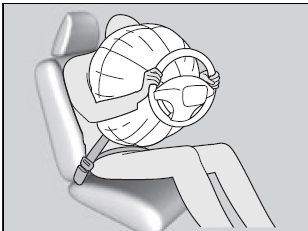
The total time for inflation and deflation is so fast that most occupants are not aware that the airbags deployed until they see them lying in front of them.
Although the driver’s and front passenger’s airbags normally inflate within a split second of each other, it is possible for only one airbag to deploy. This can happen if the severity of a collision is at the margin, or threshold, that determines whether or not the airbags will deploy. In such cases, the seat belt will provide sufficient protection, and the supplemental protection offered by the airbag would be minimal.
- When front airbags should not deploy
Minor frontal crashes: Front airbags were designed to supplement seat belts and help save lives, not to prevent minor scrapes, or even broken bones that might occur during a less than moderate-to-severe frontal crash.
Side impacts: Front airbags can provide protection when a sudden deceleration causes a driver or front passenger to move toward the front of the vehicle. Side airbags and side curtain airbags have been specifically designed to help reduce the severity of injuries that can occur during a moderate-to-severe side impact which can cause the driver or passenger to move toward the side of the vehicle.
Rear impacts: Head restraints and seat belts are your best protection during a rear impact. Front airbags cannot provide any significant protection and are not designed to deploy in such collisions.
Rollovers: In a rollover, your best form of protection is a seat belt or, if your vehicle is equipped with a rollover sensor, both a seat belt and a side curtain airbag. Front airbags, however, are not designed to deploy in a rollover as they would provide little if any protection. - When front airbags deploy with little or no visible damage
Because the airbag system senses sudden deceleration, a strong impact to the vehicle framework or suspension might cause one or more of the airbags to deploy. Examples include running into a curb, the edge of a hole, or other low fixed object that causes a sudden deceleration in the vehicle chassis. Since the impact is underneath the vehicle, damage may not be readily apparent. - When front airbags may not deploy, even though exterior damage appears severe
Since crushable body parts absorb crash energy during an impact, the amount of visible damage does not always indicate proper airbag operation. In fact, some collisions can result in severe damage but no airbag deployment because the airbags would not have been needed or would not have provided protection even if they had deployed.
Advanced Airbags
The airbags have advanced features to help reduce the likelihood of airbag related injuries to smaller occupants.
The driver’s advanced airbag system includes a seat position sensor.
Based on information from this sensor and the severity of the impact, the advanced airbag system determines the optimal deployment of the driver’s airbag.
The front passenger’s advanced airbag system has weight sensors. The sensors are used for occupant classification to activate or deactivate the front passenger’s airbag.
For adult size occupants, the system will automatically activate the front passenger’s airbag. If a small adult sits in the front passenger seat and the system does not recognize him/her as an adult, see
Passenger Airbag Off Indicator P. 65
If there is a problem with the driver’s seat position sensor or the passenger’s seat weight sensors, the SRS indicator will come on, and in the event of a crash, the airbag will deploy (regardless of the driver’s seating position or passenger’s occupant classification) with a force corresponding to the severity of the impact.
Supplemental Restraint System (SRS)
Indicator P. 64
For the advanced front airbags to work properly, confirm that:
- The occupant is sitting in an upright position, wearing the seat belt properly and the seat-back is not excessively reclined.
The occupant is not leaning against the door or center console.
The occupant’s feet are placed on the floor in front of them.
There are no objects hanging from the front passenger’s seat.
Only small, lightweight objects are in the seat-back pocket.
The steering wheel and passenger’s side dashboard are not obstructed by any object.
No liquid has been spilled on or under the seat.
We advise against allowing a child age 12 or under to ride in the front passenger’s seat. However, if you do allow a small child or infant to ride in the front passenger’s seat, the system is designed to automatically deactivate the front passenger’s airbag. Do not let a small child or infant ride in the front passenger’s seat if the airbag does not automatically deactivate.
- There is no child seat or other object pressing against the rear of the seat or seat-back.
There is no rear passenger pushing or pulling on the back of the front passenger’s seat.
There are no objects placed under or beside the front passenger’s seat. Improperly positioned objects can interfere with the advanced airbag sensors.
The head restraint is not contacting the roof. - The floor mat behind the front passenger’s seat is set in the correct position evenly on the floor. An improperly placed mat can interfere with the advanced airbag sensors.
Knee Airbags
The knee SRS airbags inflate in a moderate-to-severe frontal collision to help keep the driver and/or front passenger in the proper position and to help maximize the benefit provided by the vehicle’s other safety features.
SRS (Supplemental Restraint System) indicates that the airbag is designed to supplement seat belts, not replace them. Seat belts are the occupant’s primary restraint system.
Housing Locations
The knee airbag for the driver and the one for the front passenger are housed under the steering column and the glove box respectively.
Both are marked SRS AIRBAG.
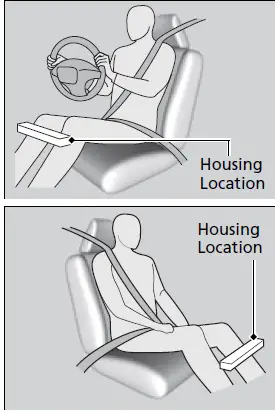
Do not attach accessories on or near a knee airbag as they can interfere with the proper operation of the airbag, or even hurt someone if the airbag inflates.
The driver and front passenger should not store any items under the seat or behind their feet. The items can interfere with proper airbag deployment in the event of a moderate to severe frontal collision and may result in inadequate protection.
Operation
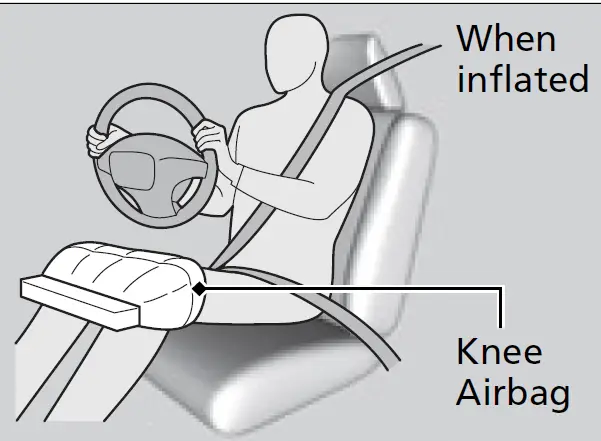
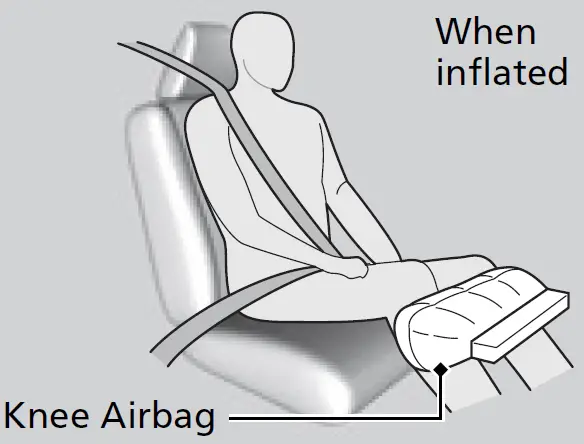
The driver’s and front passenger’s knee airbag deploy at the same time as the driver’s and front passenger’s airbag, respectively.
Even if the collision is not severe enough to deploy the front airbags, the knee airbags may inflate alone.
- When knee airbags deploy with little or no visible damage
Because the airbag system senses sudden deceleration, a strong impact to the vehicle framework or suspension might cause one or more of the airbags to deploy. Examples include running into a curb, the edge of a hole, or other low fixed objects that cause a sudden deceleration in the vehicle chassis. Since the impact is underneath the vehicle, damage may not be readily apparent. - When knee airbags may not deploy, even though exterior damage appears severe
- Since crushable body parts absorb crash energy during an impact, the amount of visible damage does not always indicate proper airbag operation. In fact, some collisions can result in severe damage but no airbag deployment because the airbags would not have been needed or would not have provided protection even if they had deployed.
Side Airbags
The side airbags help protect the torso and pelvis of the driver, front passenger, or an outer rear seat occupant during a moderate-to-severe side impact.
Housing Locations
The side airbags are housed in the outside edge of the driver’s and passenger’s seat-backs and next to the outer rear seating positions.
Each are marked SIDE AIRBAG.
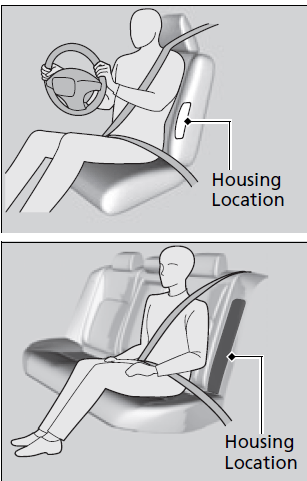
Make sure you and your front seat and rear outboard passengers always sit upright. Leaning into the path of a side airbag can prevent the airbag from deploying properly and increases the risk of serious injury.
Do not attach accessories on or near the side airbags. They can interfere with the proper operation of the airbags, or hurt someone if an airbag inflates.
Do not cover or replace the front seat-back covers without consulting a dealer.
Improperly replacing or covering front seat-back covers can prevent your side airbags from properly deploying during a side impact.
Operation
When the sensors detect a moderate-to-severe side impact, the control unit signals the side airbag on the impact side to immediately inflate.
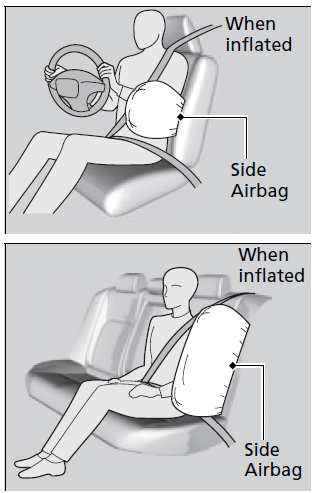
- When a side airbag deploys with little or no visible damage
Because the airbag system senses sudden acceleration, a strong impact to the side of the vehicle’s framework can cause a side airbag to deploy. In such cases, there may be little or no damage, but the side impact sensors detected a severe enough impact to deploy the airbag.
When a side airbag may not deploy, even though visible damage appears severe
It is possible for a side airbag not to deploy during an impact that results in apparently severe damage. This can occur when the point of impact was toward the far front or rear of the vehicle, or when the vehicle’s crushable body parts absorbed most of the crash energy. In either case, the side airbag would not have been needed nor provided protection even if it had deployed.
Side Curtain Airbags
The side curtain airbags help protect the heads of the driver and passengers in the outer seating positions during a moderate-to-severe side impact. The side curtain airbags equipped in this vehicle are also designed to help reduce the likelihood of partial and complete ejection of vehicle occupants through side windows in crashes, particularly rollover crashes.
Housing Locations
The side curtain airbags are located in the ceiling above the side windows on both sides of the vehicle.

Operation
The side curtain airbag is designed to deploy in a rollover or a moderate-to-severe side impact.
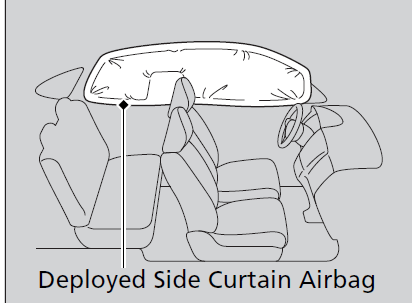
To get the best protection from the side curtain airbags, occupants should wear their seat belts properly and sit upright and well back in their seats.
Do not attach any objects to the side windows or roof pillars as they can interfere with the proper operation of the side curtain airbags.
If the impact is on the passenger’s side, the passenger’s side curtain airbag deploys even if there are no occupants on that side of the vehicle.
If the SRS control unit senses that your vehicle is about to rollover, it immediately deploys both side curtain airbags and activates the seat belt tensioners for the front seats and outer rear seats.
- When side curtain airbags deploy in a frontal collision
One or both side curtain airbags may also inflate in a moderate-to-severe angled frontal collision.
Airbag System Indicators
If a problem occurs in the airbag system, the SRS indicator will come on and a message appears on the driver information interface.
Supplemental Restraint System (SRS) Indicator
When the power mode is set to ON
The indicator comes on for a few seconds, then goes off. This tells you the system is working properly.

If the indicator comes on at any other time, or does not come on at all, have the system checked by a dealer as soon as possible. If you don’t, your airbags and seat belt tensioners may not work properly when they are needed.
WARNING
Ignoring the SRS indicator can result in serious injury or death if the airbag systems or tensioners do not work properly.
Have your vehicle checked by a dealer as soon as possible if the SRS indicator alerts you to a possible problem.
Passenger Airbag Off Indicator
- When the passenger airbag off indicator comes on
The indicator comes on to alert you that the passenger’s airbag has been turned off.
This occurs if the seat is empty or when the weight sensors determine that a small child or infant is on the passenger seat.
Children age 12 or under should always ride properly restrained in a back seat.
Child Safety P. 68
If the indicator is on, in the event of a crash the passenger’s airbag will not deploy. The passenger’s knee airbag will not deploy, either.
To ensure the passenger is detected properly, confirm that:
- The occupant is sitting in an upright position, wearing the seat belt properly and the seat-back is not excessively reclined.
The occupant is not leaning against the door or center console.
The occupant’s feet are placed on the floor in front of them.
There are no objects hanging from the front passenger’s seat.
Only small, lightweight objects are in the seat-back - No liquid has been spilled on or under the seat.
There is no child seat or other object pressing against the rear of the seat or seat-back.
There is no rear passenger pushing or pulling on the back of the front passenger’s seat.
There are no objects placed under or beside the front passenger’s seat. Improperly positioned objects can interfere with the advanced airbag sensors.
The floor mat behind the front passenger’s seat is set in the correct position evenly on the floor. An improperly placed mat can interfere with the advanced airbag sensors.
The head restraint is not contacting the roof.
The passenger airbag off indicator may come on and go off periodically if the total weight on the seat is near the airbag cutoff threshold. For a small adult, depending on physique and posture, the system may not recognize him/her as an adult and thus deactivate the passenger’s airbag.
If this occurs, please confirm that the conditions set forth in the above bullet points on the previous page are met.
If the above conditions are met and the indicator is still on, then with the transmission in park, set the power mode to OFF and back to ON.
Have your vehicle checked by a dealer as soon as possible if:
- All of the above conditions are met, and the indicator comes on with an adult seated in the front passenger seat.
The seat is empty and the indicator is off.
Do not allow an adult passenger to ride in the front seat when the indicator is on.
Airbag Care
You do not need to, and should not, perform any maintenance on or replace any airbag system components yourself. However, you should have your vehicle inspected by a dealer in the following situations:
- When the airbags have deployed
If an airbag has inflated, the control unit and other related parts must be replaced. Similarly, once an automatic seat belt tensioner has been activated, it must be replaced. - When the vehicle has been in a moderate-to-severe collision
Even if the airbags did not inflate, have your dealer inspect the following: the driver’s seat position sensor, weight sensors in the passenger’s seat, seat belt tensioners for the front seats and outer rear seats, and each seat belt that was worn during the crash. - Do not remove or modify a front seat without consulting a dealer
This would likely disable or affect the proper operation of the driver’s seat position sensor or the weight sensors in the passenger’s seat. If it is necessary to remove or modify a front seat to accommodate a person with disabilities, contact an Acura dealer, or for U.S. vehicles, Acura Client Relations at 1-800-382-2238 and for Canadian vehicles, Acura Client Services at 1-888-9-ACURA-9.
We recommend against the use of salvaged airbag system components, including the airbag, tensioners, sensors, and control unit.
Child Safety
Protecting Child Passengers
Each year, many children are injured or killed in vehicle crashes because they are either unrestrained or not properly restrained. In fact, vehicle crashes are the number one cause of death of children ages 12 and under.
To reduce the number of child deaths and injuries, every state, Canadian province and territory requires that infants and children be properly restrained when they ride in a vehicle.
Children should sit properly restrained in a rear seat. This is because:
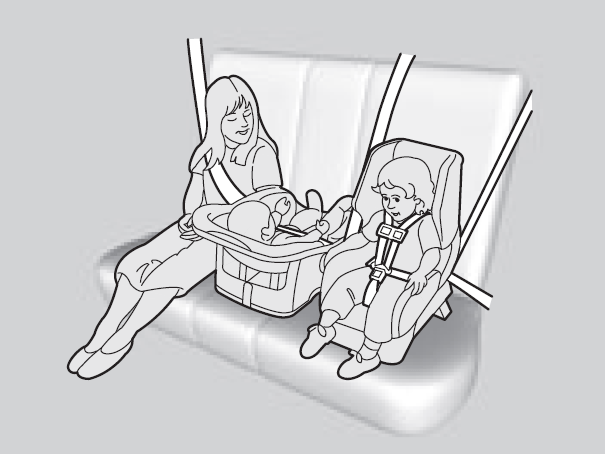
An inflating front airbag can injure or kill a child sitting in the front seat.
A child in the front seat is more likely to interfere with the driver’s ability to safely control the vehicle.
Statistics show that children of all sizes and ages are safer when they are properly restrained in a rear seat.
WARNING
Children who are unrestrained or improperly restrained can be seriously injured or killed in a crash.
Any child too small for a seat belt should be properly restrained in a child seat. A larger child should be properly restrained with a seat belt, using a booster seat if necessary.
The National Highway Traffic Safety Administration and Transport Canada recommend that all children ages 12 and under be properly restrained in a rear seat. Some states or provinces/territories have laws restricting where children may ride.
- Never hold a child on your lap because it is impossible to protect them in the event of a collision.
Never put a seat belt over yourself and a child. During a crash, the belt would likely press deep into the child and cause serious or fatal injuries.
Never let two children use the same seat belt. Both children could be very seriously injured in a crash.
Any child who is too small to wear a seat belt correctly must be restrained in an approved child seat that is properly secured to the vehicle using either the seat belt or the lower anchors of the LATCH system.
Do not allow children to operate the doors, windows, or seat adjustments.
Do not leave children in the vehicle unattended, especially in hot weather when the inside of the vehicle can get hot enough to kill them. They could also activate vehicle controls causing it to move unexpectedly.
WARNING
Allowing a child to play with a seat belt or wrap one around their neck can result in serious injury or death.
Instruct children not to play with any seat belt and make sure any unused seat belt a child can reach is buckled, fully retracted, and locked.
To deactivate a lockable retractor, release the buckle and allow the seat belt to wind up all the way.
To remind you of the passenger’s front airbag hazards and child safety, your vehicle has warning labels on the dashboard (U.S. models) and on the front visors. Please read and follow the instructions on these labels.
Safety of Infants and Small Children
Protecting Infants
An infant must be properly restrained in a rear-facing child seat until the infant reaches the seat manufacturer’s weight or height limit for the seat.
- Positioning a rear-facing child seat
Child seats must be placed and secured in a rear seating position.

When properly installed, a rear-facing child seat may prevent the driver or a front passenger from moving their seat all the way back, or from locking their seat-back in the desired position. Make sure that there is no contact between the child seat and the seat in front of it.
It can also interfere with proper operation of the passenger’s advanced front airbag system.
Airbags P. 49
If this occurs, we recommend that you install the child seat directly behind the front passenger’s seat, move the seat as far forward as needed, and leave it unoccupied. Or, you may wish to get a smaller rear-facing child seat.
WARNING
Placing a rear-facing child seat in the front seat can result in serious injury or death during a crash.
Always place a rear-facing child seat in the rear seat, not the front.
Experts recommend use of a rear-facing seat for a child so long as the child’s height and weight are appropriate for a rear-facing seat.
Infants should never be seated in a forward-facing position.
Always refer to the child seat manufacturer’s instructions before installation.
Do not allow a front seat to rest against a child seat installed in a rear seating position.
The weight sensor in the front seat may not correctly detect the actual weight of the occupant.
Protecting Smaller Children
If a child has exceeded the weight and height limitations of a rear-facing child seat, the child should be properly restrained in a firmly secured forward-facing child seat until they exceed the weight and height limitations for the forward-facing child seat.
Forward-facing child seat placement
We strongly recommend placing a forward-facing child seat in a rear seating position.

Placing a forward-facing child seat in the front seat can be hazardous, even with advanced front airbags that automatically turn the passenger’s front airbag off. A rear seat is the safest place for a child.
WARNING
Placing a forward-facing child seat in the front seat can result in serious injury or death if the front airbag inflates.
If you must place a forward-facing child seat in front, move the vehicle seat as far back as possible, and properly restrain the child.
Educate yourself about the laws and regulations regarding child seat use where you are driving, and follow the child seat manufacturer’s instructions.
Selecting a Child Seat
Most child seats are LATCH-compatible (Lower Anchors and Tethers for Children). Some have a rigid-type connector while others have a flexible-type connector. Both are equally easy to use. Some existing and previously owned child seats can only be installed using the seat belt. Whichever type you choose, follow the child seat manufacturer’s use and care instructions including recommended expiration dates as well as the instructions in this manual. Proper installation is key to maximizing your child’s safety.
In seating positions and vehicles not equipped with LATCH, a LATCH-compatible child seat can be installed using the seat belt and a top tether for added security. This is because all child seats are required to be designed so that they can be secured with a lap belt or the lap part of a lap/shoulder belt. In addition, the child seat manufacturer may advise that a seat belt be used to attach a LATCH-compatible seat once a child reaches a specified weight. Please read the child seat owner’s manual for proper installation instructions.
- Important consideration when selecting a child seat
Make sure the child seat meets the following three requirements:
The child seat is the correct type and size for the child.
The child seat is the correct type for the seating position.
The child seat is compliant with Federal Motor Vehicle Safety Standard 213 or Canadian Motor Vehicle Safety Standard 213.
Installation of a LATCH-compatible child seat is simple.
LATCH-compatible child seats have been developed to simplify the installation process and reduce the likelihood of injuries caused by incorrect installation.
Installing a LATCH-Compatible Child Seat
A LATCH-compatible child seat can be installed in either of the two outer rear seats. A child seat is attached to the lower anchors with either the rigid or flexible type of connectors.
- Locate the anchor marks affixed to the base of the seat cushion.
- Pull out the anchor covers under the marks to expose the lower anchors.
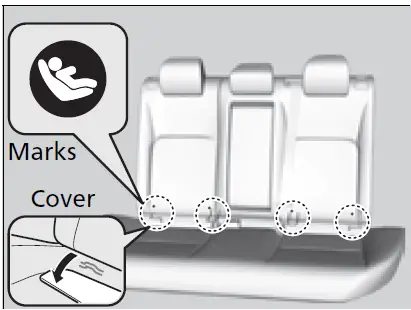
- Place the child seat on the vehicle seat, then attach the child seat to the lower anchors according to the instructions that came with the child seat.
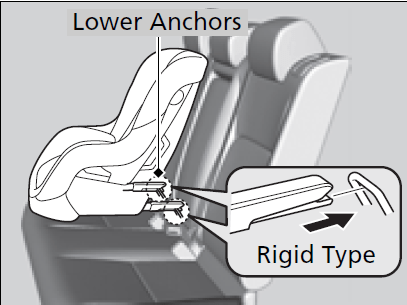
- When installing the child seat, make sure that the lower anchors are not obstructed by the seat belt or any other object.
WARNING
Never attach two child seats to the same anchor. In a collision, one anchor may not be strong enough to hold two child seat attachments and may break, causing serious injury or death.
For your child’s safety, when using a child seat installed using the LATCH system, make sure that the child seat is properly secured to the vehicle.
A child seat that is not properly secured will not adequately protect a child in a crash and may cause injury to the child or other vehicle occupants.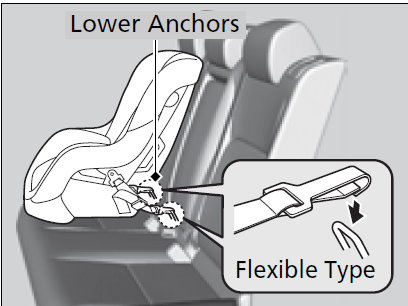
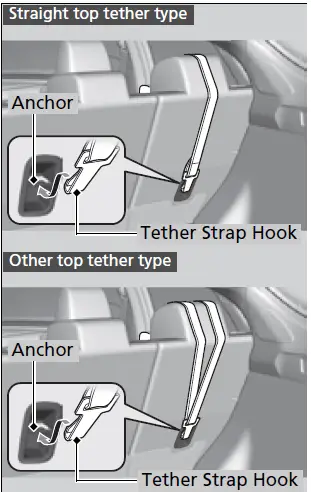
- When installing the child seat, make sure that the lower anchors are not obstructed by the seat belt or any other object.
- Remove the cargo area cover.
- Cargo Area Cover P. 209
- Route the tether strap over the top of the head restraint.
Make sure the strap is not twisted. - Secure the tether strap hook to the anchor.
- Tighten the tether strap as instructed by the child seat manufacturer.
Make sure the child seat is firmly secured by rocking it forward and back and side to side; little movement should be felt. - Make sure any unused seat belt that a child can reach is buckled, the lockable retractor is activated, and the belt is fully retracted and locked.
WARNING
Using the outer rear seats’ inner anchors to secure a LATCH-compatible child seat in the center seating position may result in failure of the child seat, causing injury or death.
Only use the outer rear seats’ inner anchors to install a child seat in the center seating position if the manufacturer’s instructions expressly permit.
Installing a LATCH-compatible child seat in the rear center seat
Each outer rear seat is equipped with a pair of lower anchors which are used to secure a LATCH-compatible child seat. The rear center seat, however, is not equipped with anchors of any kind.
The inner and outer anchors are spaced apart at a standard distance of 11 inches (280 mm). The distance between the two inner anchors is 15 inches (380 mm). LATCH-compatible restraint systems that are fitted with rigid-type attachments cannot be installed in the rear center seat. However, a system fitted with flexible-type attachments can be installed in the center seat, provided that the manufacturer’s instructions for that system permit the use of the inner anchors with the stated spacing.
Before seating a child, make sure that the system is properly attached to both the lower anchors and tether anchors.
Installing a Child Seat with a Lap/Shoulder Seat Belt
A child seat can be installed with a lap/shoulder belt in any rear seat or, if absolutely necessary, the front passenger seat.
- Place the child seat on the vehicle seat.
- Route the seat belt through the child seat according to the seat manufacturer’s instructions, and insert the latch plate into the buckle.
- Insert the latch plate fully until it clicks.
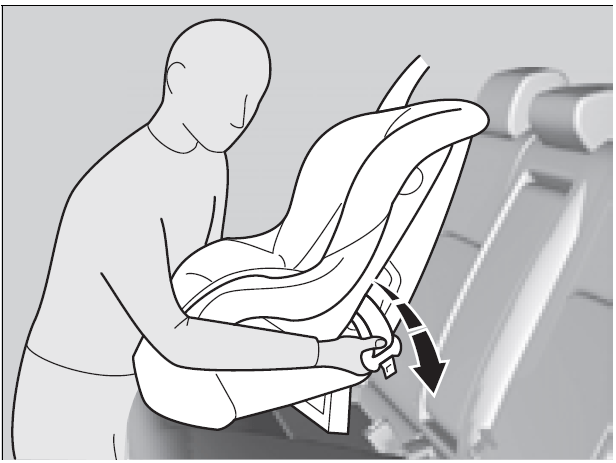
- Insert the latch plate fully until it clicks.
- Slowly pull the shoulder part of the belt all the way out until it stops. This activates the lockable retractor.
- Let the seat belt retract a few inches and check that the retractor has switched modes by pulling on the webbing. It should not pull out again until it is reset by removing the latch plate from the buckle.
- If you are able to pull the shoulder belt out, the lockable retractor is not activated. Slowly pull the seat belt all the way out, and repeat steps 3 – 4.
A child seat that is not properly secured will not adequately protect a child in a crash and may cause injury to the child or other vehicle occupants.
- If you are able to pull the shoulder belt out, the lockable retractor is not activated. Slowly pull the seat belt all the way out, and repeat steps 3 – 4.
- Grab the shoulder part of the seat belt near the buckle, and pull up to remove any slack from the lap part of the belt.
- When doing this, place your weight on the child seat and push it into the vehicle seat.

- When doing this, place your weight on the child seat and push it into the vehicle seat.
- Make sure the child seat is firmly secured by rocking it forward and back and side to side; less than one inch of movement should occur near the seat belt.
- Make sure any unused seat belt that a child can reach is buckled, the lockable retractor is activated, and the belt is fully retracted and locked.
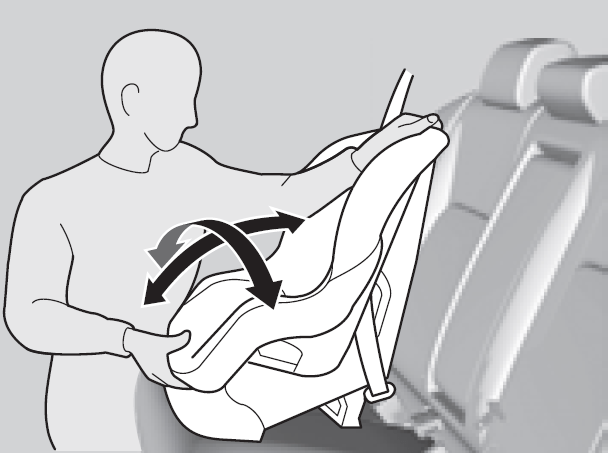
To deactivate a lockable retractor, release the buckle and allow the seat belt to wind up all the way.
Adding Security with a Tether
A tether anchor point is provided behind each rear seating position.
If you have a child seat that comes with a tether but can be installed with a seat belt, the tether may be used for additional security.
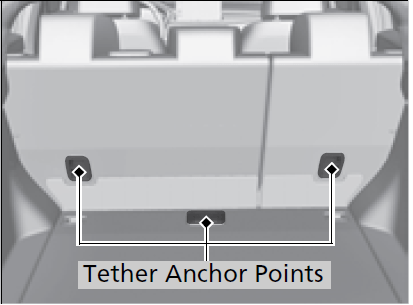
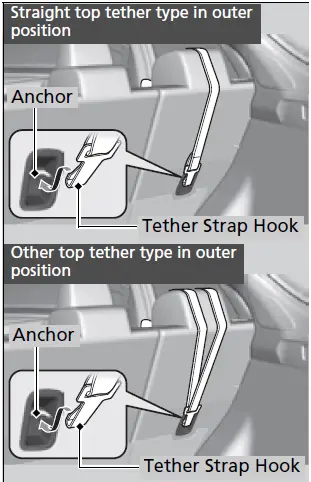
Using an outer anchor
- Remove the cargo area cover.
- Cargo Area Cover P. 209
Locate the appropriate tether anchor point. - Route the tether strap over the top of the head restraint. Make sure the strap is not twisted.
- Secure the tether strap hook to the anchor.
- Tighten the tether strap as instructed by the child seat manufacturer.
Always use a tether for forward-facing child seats whether using the seat belt or lower anchors.
Using the center anchor

- Remove the cargo area cover.
- Cargo Area Cover P. 209
Locate the appropriate tether anchor point and lift the cover. - Route the tether strap over the top of the head restraint. Make sure the strap is not twisted.
- Secure the tether strap hook to the anchor.
- Tighten the tether strap as instructed by the child seat manufacturer.
Safety of Larger Children
Protecting Larger Children
The following pages give instructions on how to check proper seat belt fit, what kind of booster seat to use if one is needed, and important precautions for a child who must sit in front..
Checking Seat Belt Fit
When a child is too big for a child seat, secure the child in a rear seat using the lap/shoulder seat belt. Have the child sit upright and all the way back, then answer the following questions.
- Checklist
- Do the child’s knees bend comfortably over the edge of the seat?
Does the shoulder belt cross between the child’s neck and arm?
Is the lap part of the seat belt as low as possible, touching the child’s thighs?
Will the child be able to stay seated like this for the whole trip?

If you answer yes to all these questions, the child is ready to wear the lap/shoulder seat belt correctly. If you answer no to any question, the child needs to ride on a booster seat until the seat belt fits properly without a booster seat.
WARNING
Allowing a child age 12 or under to sit in front can result in injury or death if the passenger’s front airbag inflates.
If a larger child must ride in front, move the vehicle seat as far to the rear as possible, have the child sit up properly and wear the seat belt properly, using a booster seat if needed.
Booster Seats
If a lap/shoulder seat belt cannot be used properly, position the child in a booster seat in the rear seat. For the child’s safety, check that the child meets the booster seat manufacturer’s recommendations.
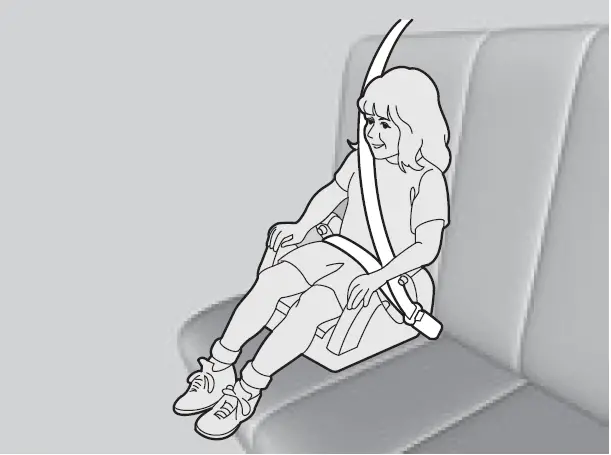
Protecting Larger Children – Final Checks
Your vehicle has a rear seat where children can be properly restrained. If you ever have to carry a group of children, and a child must ride in front:
- Make sure you read and fully understand the instructions and safety information in this manual.
Move the front passenger seat as far back as possible.
Have the child sit upright and well back in the seat.
Check that the seat belt is properly positioned so that the child is secure in the seat.
Monitoring child passengers
We strongly recommend that you keep an eye on child passengers. Even older, more mature children sometimes need to be reminded to fasten their seat belts and sit up properly.
When installing a booster seat, make sure to read the instructions that came with it, and install the seat accordingly.
There are high- and low-type booster seats. Choose a booster seat that allows the child to wear the seat belt correctly.
Some U.S. states, and Canadian provinces and territories require children to use a booster seat until they reach a given age or weight (e.g., 6 years or 60 lbs). Be sure to check current laws in the state or province, or territory where you intend to drive.
Exhaust Gas Hazard
Carbon Monoxide Gas
The engine exhaust from this vehicle contains carbon monoxide, a colorless, odorless, and highly toxic gas. As long as you properly maintain your vehicle, carbon monoxide gas will not get into the interior.
- Have the exhaust system inspected for leaks whenever
- The exhaust system is making an unusual noise.
The exhaust system may have been damaged.
The vehicle is raised for an oil change.
When you operate a vehicle with the hatch open, airflow can pull exhaust gas into the interior and create a hazardous condition. If you must drive with the hatch open, open all the windows and set the climate control system as shown below.
- Select the fresh air mode.
- Select the mode.
- Set the fan speed to high.
- Set the temperature control to a comfortable setting.
Adjust the climate control system in the same manner if you sit in your parked vehicle with the engine running.
WARNING
Carbon monoxide gas is toxic.
Breathing it can cause unconsciousness and even kill you.
Avoid any enclosed areas or activities that expose you to carbon monoxide.
An enclosed area such as a garage can quickly fill up with carbon monoxide gas.
Do not run the engine with the garage door closed. Even when the garage door is open, drive out of the garage immediately after starting the engine.
Safety Labels
Label Locations

FAQ
The 2023 Acura Integra is likely to come equipped with three-point seat belts for both the front and rear passengers.
Yes, the front seat belts are usually adjustable in terms of length to accommodate different passenger sizes.
Yes, modern vehicles like the Acura Integra often feature seat belt pretensioners that tighten the seat belts during a collision to reduce occupant movement.
The 2023 Acura Integra is likely to come equipped with multiple airbags, including frontal airbags, side airbags, and potentially curtain airbags.
Yes, the Acura Integra is likely to have side-impact airbags that deploy in the event of a side collision to provide additional protection to occupants.
Knee airbags are not typically a standard feature in all vehicles, but it’s possible that the Acura Integra might have them for added safety.
Yes, modern airbag systems are designed to deploy with varying force depending on the severity of the collision and the position of the occupants.
Airbag cutoff switches are generally not common, as airbags are crucial for passenger safety. However, there might be a system to detect a child or lightweight passenger and adjust airbag deployment accordingly.
It’s important to prioritize safety, so airbag systems are usually not designed to be manually turned off by the driver or passengers.
Yes, many modern vehicles include a passenger sensing system that can detect the presence and weight of a passenger in the front seat to adjust airbag deployment.
The Acura Integra might have curtain airbags that deploy from the roofline to provide protection to both front and rear passengers.
Yes, airbags are an integral part of the vehicle’s overall safety system, which also includes seat belts, structural design, and other safety features.
Modern vehicles often have onboard diagnostics that can detect airbag system faults and issues, which are usually indicated by warning lights on the dashboard.
Yes, the Acura Integra is likely to have LATCH anchors and recommendations for properly securing child safety seats.
Modern vehicles often come with advanced safety technologies like automatic emergency braking, lane departure warning, and adaptive cruise control, which can work alongside seat belts and airbags to enhance overall safety.
Useful Link
View Full User Guide: Acura Integra 2023 User Guide
ACURA Integra 2023 Display Gauges and Indicators User Guide
2024 Acura INTEGRA Specs, Price, Features, Mileage (Brochure)
Related Article:
2023 Acura TLX Specs, Price, Features, Mileage (Brochure)


